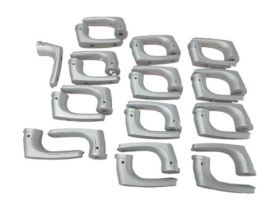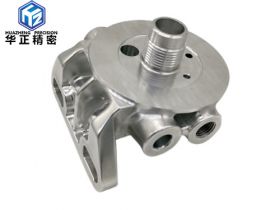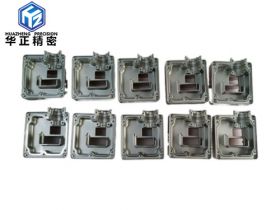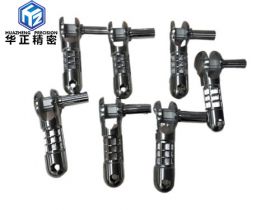Technology Center
Recommended Products
Contact Us
Contact Person: Cindy Zhu
TEL:+86 13418453374
What are the techniques to avoid deformation in hardware processing?
What are the techniques to avoid deformation in hardware processing?
There are many factors that cause deformation of aluminum parts, which are closely related to the material of the parts, the external and internal structure of the parts, and the manufacturing conditions of the products. There are mainly deformation caused by the internal stress of the blank, cutting force, cutting heat and deformation caused by clamping force. So what are the technological measures to reduce the deformation of aluminum parts?
Reduce the internal stress of the blank: Using the principles of natural or artificial aging and vibration, it can partially consume the internal stress of the blank. Pre-processing is also a more effective process method. For the blank, the remaining amount is relatively large, so After processing, the deformation will be relatively large. If the excess part of the blank is processed in advance and the margin of each part is reduced, not only can the processing deformation of the subsequent process be reduced, but also a part of the internal stress can be released after the pre-processing is placed for a period of time.
Second, improve the cutting ability of the tool: the material of the tool and several parameters will have an impact on the cutting force and cutting heat. The correct selection of the tool to reduce the deformation caused by the part processing is very important. Reasonable selection of parameters; 1. The rake angle, under the condition of maintaining the strength of the cutting edge, a larger rake angle can not only grind a better sharp edge, but also reduce cutting deformation and make chip removal more Smoothly, reduce the cutting force and cutting temperature, never use negative rake angle tools; 2. The clearance angle, the size of the clearance angle has a direct relationship with the wear of the flank surface and the quality of the machined surface, the cutting thickness is selected The important condition of the angle, in rough milling, because the feed rate is relatively large, the cutting load is heavier, and the heat generation is also greater. The heat dissipation condition of the tool is required to be good enough. Therefore, the back angle should be selected smaller and fine milling. At the time, the cutting edge is required to be sharp enough to reduce the friction between the rear tool and the machined surface and reduce the elastic deformation. Therefore, the relief angle should be selected larger; 3.Helix angle, in order to make the milling more stable and reduce the milling force, the helix angle should be Make it as large as possible; 4. The entering angle. Appropriately reducing the entering angle can improve the heat dissipation conditions and reduce the average temperature of the processed area.
Improve the structure of the tool: 1. Reduce the number of teeth of the milling cutter and increase the chip holding space. Because the plasticity of the aluminum material is relatively large, the cutting deformation during processing is also relatively large, and a larger chip holding space is required, so, The bottom radius of the chip flute should be larger, and the number of teeth of the milling cutter should be less; 2. For fine grinding of the cutter teeth, the roughness of the cutting edge of the cutter teeth should be less than Ra=0.4um, and it should be used before using a new tool Gently grind the fine oil stone on the front and back of the teeth to eliminate the slight jagged lines and burrs remaining when sharpening the teeth. This can reduce the cutting heat and reduce the cutting deformation; 3. Strictly control the tool's Wear standard. After the tool is worn, the surface roughness value of the cost increases, and the cutting temperature rises, and the deformation of the parts will increase. Therefore, in addition to choosing tool materials with better wear resistance, the wear standard of the tool needs to be less than 0.2mm, otherwise If it is easy to produce chip edge, the temperature of the part should be controlled within one hundred degrees during cutting to prevent deformation.
Fourth, improve the clamping method of parts. For some thin-walled aluminum parts with relatively poor rigidity, the following methods can be used to clamp to reduce their deformation: 1. For the kind of thin-walled bushings, if It uses a three-jaw self-centering chuck or a spring chuck to clamp from the radial direction. Once it is loosened after processing, the parts will inevitably be deformed. At this time, the axial end face compression method with better rigidity should be used to To locate the inner hole of the part, make a self-made threaded mandrel and insert it into the inner hole of the part. Use a modified version to compress the end face and tighten it with a nut to avoid deformation caused by clamping when processing the outer circle. , So as to obtain satisfactory processing accuracy; 2. When processing thin-walled plate parts, it is best to choose a vacuum suction cup to obtain a more uniform clamping force, and then process with a smaller cutting amount, which can be very good To prevent parts from deforming;
In addition, packing can also be used. In order to increase the process rigidity of thin-walled parts, media can be filled inside to reduce the deformation caused during clamping and cutting, such as filling the workpiece with 3% Up to 6 percent of potassium nitrate urea melt, after processing, soak the parts in water or alcohol to dissolve the filling and pour it out.
Reasonable arrangement of processing procedures: When performing high-speed cutting, due to the relatively large machining allowance and intermittent cutting, the cutting process is often prone to vibration, which affects the accuracy and surface roughness of the processing, so the CNC high-speed cutting processing technology The process can generally be divided into rough machining, semi-precision machining, clear corner machining, and precision machining. For parts and components with high precision requirements, sometimes it is necessary to perform secondary semi-precision machining, and then perform precision machining. After rough machining, the parts can be naturally cooled to eliminate internal stress caused by rough machining, reduce deformation, and leave after rough machining The margin should be greater than the amount of deformation, generally 1-2 mm. During precision machining, the surface of the parts needs to be processed uniformly, generally 0.2-0.5mm is better, so that the tool is in the process of processing In a stable state, the cutting deformation can be greatly reduced, and a good surface processing quality can be obtained, thereby ensuring the processing accuracy of the product.
















